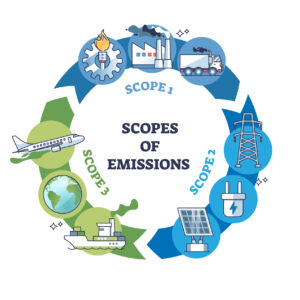The Garden Division of FITT announces its entry into Make It Zero, a global initiative launched by EDRA/GHIN to tackle greenhouse gas emissions in the DIY sector. With a particular focus on Scope 3 emissions, Make It Zero aims to mobilize the global value chain to collaborate and expand decarbonization efforts. Shared goals and commitment […]
The Carbon Footprint of Organization: GHG Inventory, Assessment Scopes, and Benefits of ISO 14064-1
The calculation of GHG emissions is a powerful scientific tool that allows to acknowledge one’s own responsibility in terms of climate-altering gas emissions and take a leading role in the fight against climate change.
While both refer to the carbon footprint, the Carbon Footprint of Organization (CFO) and the Carbon Footprint of Product (CFP) differ in terms of analysis and scope of emissions.
CFP evaluates the specific environmental impact of a single product throughout its lifecycle and is regulated by the UNI EN ISO 14067 standard.
CFO is an assessment of the GHG emissions – direct and indirect – generated by all the organization’s activities, including production processes, energy supplies, transport, waste management, and other aspects of the organisation.
CFO is regulated by the UNI EN ISO 14064-1 standard, an international standard that provides guidelines for designing, managing, reporting, and verifying a GHG emissions inventory, and ensures consistency and reliability of the reported data.
GHG Inventory and Assessment Scopes – Scope 1, 2, and 3
A GHG inventory quantifies all greenhouse gas emissions produced by the company’s activities over a specific period, typically one year.
The inventory creation process begins with the definition of the organizational boundaries, continues with the identification of the emissions associated with business activities (classified as direct or indirect), and concludes with the calculation and sharing of results.
A GHG inventory consists of three distinct scopes or assessment areas that allow to calculate emissions for every stage of the production chain.
Scope 1
It includes direct emissions, related to the company’s own or controlled activities. This includes emissions released during industrial processes and on-site production (e.g. factory fumes and chemicals), emissions from fossil fuels to power the company fleet, or to fuel heating boilers.
Scope 2 and 3 quantify indirect emissions, i.e. those arising from activities related to but not directly controlled by the company.
Scope 2
It includes indirect emissions resulting from purchased energy sources, generated off-site and consumed by the company, such as electricity, steam, heat or cooling.
Scope 3
It includes indirect emissions that are part of the company’s value chain, in the upstream and downstream phases. Although they are generated by assets, plants or processes not directly controlled by the company, these emissions are equally attributable to the company’s activities.
Upstream emissions include indirect greenhouse gas emissions related to goods and services purchased and generated from cradle to gate.
Downstream emissions include indirect greenhouse gas emissions related to the goods and services sold and emitted after such goods or services have left the ownership or control of the company.

Benefits of EN ISO 14064-1
Process and activity efficiency: measuring the carbon footprint helps identify and better understand the primary sources of greenhouse gas emissions throughout the value chain and business operations. This enables the development of targeted strategies to reduce emissions, improve energy efficiency, and optimize production cycles.
Corporate reputation: the GHG emissions certification demonstrates a company’s concrete commitment to environmental sustainability and the reduction of its impact on the climate crisis, improves its positioning, and increases the trust of partners and customers thanks to the implementation of a transparent reporting process.
Competitive advantage: A well-structured GHG inventory differentiates a company from competitors and creates new market opportunities.
Communication: the company demonstrates to be at the forefront of the fight against climate change and communicates its commitment with scientifically based actions.
Participation in tenders and new opportunities: the GHG emissions certification can become a requirement for participation in tenders, collaboration with sustainability-focused organizations, or access to tax incentives and financing tied to ESG criteria.
FITT and the UNI EN ISO 14064-1 certification
After certifying its systematic approach to the product carbon footprint, FITT’s GHG inventory has been third-party verified in compliance with the ISO 14064 standard: therefore, FITT has also certified the Carbon Footprint of Organisation.
The calculation of GHG emissions is for FITT a powerful scientific tool that allows it to recognize its own responsibility for greenhouse gas emissions and take a leading role in the fight against climate change.
Once again, FITT has demonstrated a quantitative and structured approach to climate impact mitigation, driven by innovation, transparency, and interdependence.